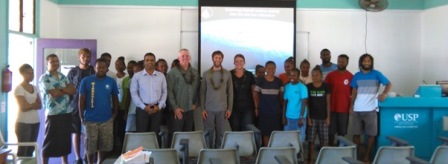Related News

The University of the South Pacific (USP) is currently collaborating with USA’s Woods Hole Oceanographic Institution (WHOI) for their research projects in the Pacific.
Mr Ruben Markward, Emalus Campus Manager, recently welcomed the team to Emalus and expressed his support for their research activities.
He noted that the campus welcomed the opportunity to be involved in their research and that it is fascinating to learn that scientists, through this research, will be able to find out more about past cyclones, dating back thousands of years.
Dr Krishna Kotra, Science Programme Coordinator, who is the collaborator from USP in their ongoing “Developing a Long Record of Extreme South Pacific Cyclones” project, expressed gratitude to be part of this highly scientific and fascinating research by a reputable institute like WHOI.
Dr Kotra said that this research study would provide useful insights of the region’s evolutionary process of the landscapes and can quantify the impacts dating back to thousands of years.
“Ten students and two technicians from the Faculty of Science, Technology and Environment (FSTE) from Emalus Campus would be part of these sampling surveys and sediment core collection and it is expected that the project would be completed in a year,” Dr Kotra added.
He noted that Emalus Campus extended full support in terms of logistics and local administrative protocols in carrying out these studies in Vanuatu.
“The participation of students in these field based studies would prepare them for future challenges and also motivate them to take further studies,” he noted.
Students will join the team’s pursuit in collection of sediment cores at various locations on Efate and outer islands and arrangements were made in this regard.
Professor Jeffrey P. Donnelly, Senior Scientist at WHOI expressed his sincere appreciation to USP in facilitating the collaboration and helping them on the ground.
“We are happy to have USP students as part of the studies and will share our expertise,” he noted.
In his presentation, he detailed the need for the studies in the Pacific and elsewhere.
He added that while it is disappointing to have data for less than two centuries, they are using high end technology like satellite imaging, carbon dating, scanning electron microscopy, X-Ray, 3D modelling and so forth to analyse the data to date back these records to to extreme cyclones dating back two to three thousand years.
Professor Donnelly explained that the critical part of these studies would be the identification of the correct sampling site and depth of the sediment cores for analysis purposes.
“Multivariate analysis and interpretations would be carried on the samples to correlate various geological, geophysical and biological impacts on these sediment formations and thus conclusions would be drawn on best possible model,” he further explained.
He hoped that the outcome would lead to further larger grants to take up more studies in the Pacific especially in Fiji and Vanuatu.